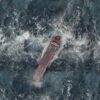

Overview
APL, which was formerly called American President Lines Ltd., is a Singapore-based container shipping company. It is a subsidiary of French shipping company CMA CGM and operates an all-containership fleet, which includes more than 150 vessels.
Near the end of the Great Depression, the U.S. government took control of the financially strapped Dollar Steamship Co. The government transferred the company’s assets to the newly formed American President Lines in 1938. Singapore-based shipping company Neptune Orient Lines (NOL) acquired APL in 1997 and moved APL’s headquarters to Singapore. CMA CGM acquired NOL in 2016, including APL.

History
The history of APL goes further back than 1938, however. Its predecessor lines date back to the 1840s. The U.S. Congress passed the Mail Steamer Bill in 1847. Under the legislation’s terms, the delivery of mail was authorized to be routed by ship from the East Coast to the Pacific Coast via the Isthmus of Panama. Two steamship routes would be operated – New York City to Chagres, Colombia on the eastern side of the isthmus, and a second route from Panama City, Colombia to Astoria, Oregon. (What is now the nation of Panama was a province of Colombia until 1903.)
William H. Aspinwall secured a 10-year government contract to haul U.S. mail, and the New York State Senate incorporated the Pacific Mail Steamship Company and Aspinwall was elected the company’s first president. Under the terms of the contract, Pacific Mail was to carry mail from Panama City to the West Coast. In return, it was paid $199,000 annually by the U.S. government.

In January 1848, the California Gold Rush began. That same month, Pacific Mail ordered three steamers and named them the SS California, SS Panama and SS Oregon. In October 1848 the SS California left from New York City to inaugurate service from Panama to the West Coast, traveling around Cape Horn to San Francisco. In addition to the mail, the Pacific Mail’s steamers sold passage to many hopeful miners.
When the Mexican-American War ended with a U.S. victory in February 1848, the nation’s West Coast extended from the Canadian border to the new border with Mexico (The Territory of California now extended to Baja California).
Prior to beginning Pacific Mail, Aspinwall had gained extensive experience in the shipping business as a partner in Howland & Aspinwall, which operated some of the most famous clipper ships ever built.
Clipper ships sacrificed cargo capacity for speed, but the fast service allowed their owners to charge premium rates. The clipper ships’ faster speed also meant that they could complete more voyages in a given time period, which helped to compensate for less cargo capacity.

(Lithograph by Endicott, New York)
The 1850s
Pacific Mail had a monopoly on the Colombia-Oregon trade, particularly after it bought two steamers from the Empire City Line. Many prospective gold miners paid for passage to California on the line’s ships. The company operated ship depots at Panama City and Benicia, California.
Pacific Mail then began a steamship line to compete with the U.S. Mail Steamship Company between New York City and Chagres. This led George Law, the president of U.S. Mail Steamship, to begin a steamship operation in the Pacific, which competed with Pacific Mail from Panama City to San Francisco.
The two companies agreed in April 1851 to buy each other’s rival fleets – the U.S. Mail Steamship Company bought Pacific Mail’s Atlantic Ocean steamers and Pacific Mail purchased U.S. Mail’s Pacific Ocean ships.

Pacific Mail’s Aspinwall invested company funds in the Panama Railroad Company, which was built to replace wagon trails across the isthmus. The railroad decreased travel time from four days to four hours.
Former rival George Law entered into a partnership with Aspinwall in 1852 and developed an eastern rail terminal next to the wharf at Aspinwall, Colombia. Law then sold his interest in 1853 to Pacific Mail. This line was completed in 1855; travel time from San Francisco to New York was cut to 21 days.
Aspinwall retired from the presidency of Pacific Mail in 1856; the company’s former secretary, William H. Davidge was promoted to the presidency. While he was president Pacific Mail’s contract with the government expired in 1858. Concurrently, U.S. Mail Steamship Company’s contract to carry mail from the U.S. East Coast to Panama City expired as well. Pacific Mail began an Atlantic Ocean service again and bought ships to operate in the Atlantic. While U.S. Mail was no longer a factor (it had gone out of business in 1859), there was fierce competition from other steamship lines. Within a few years, Pacific Mail again retreated from routes in the Atlantic Ocean.

The Civil War and the remainder of the 1860s
During the War Between the States (1861-65), Pacific Mail’s steamers transported gold from California to the East Coast for the United States. By the end of the war Pacific Mail had new leadership, and the company acquired its major competitor, the Atlantic Mail Steamship Company, which provided service from New York to the isthmus. Pacific Mail provided uncontested service from New York to the West Coast via the isthmus.
The U.S. government awarded the first mail contract between San Francisco and Hong Kong (via the Sandwich Islands [known now as the Hawaiian Islands] and Japan). The contract was worth $500,000 annually (about $8.4 million today) to its recipient – Pacific Mail.
The line’s SS Colorado was chosen for the new route from San Francisco to China and Japan. In 1867, the Colorado was the first steamship to start regular service across the Pacific; it ran from San Francisco to Yokohama, Japan and onward to Hong Kong.
Pacific Mail was running four different lines by 1867:
- The Atlantic Line, which provided service between New York and Aspinwall, Panama. Ships ran three times monthly.
- The Pacific Line, which linked with the Atlantic Line. It ran ships between Panama and San Francisco, stopping at Acapulco and Manzanillo. This route also ran three times monthly.
- The China Line, between San Francisco and Hong Kong, stopping at Yokohama. This line ran once monthly and linked with the Pacific Line.
- The Shanghai Line, which ran between Yokohama and Shanghai, via Nagasaki, Japan. This also ran once monthly, and linked with the China Line.
With these services, Pacific Mail could move freight from New York to Yokohama in 42 days, to Shanghai in 47 days and Hong Kong in 50 days. By the end of 1867, Pacific Mail owned 25 ships.
The Transcontinental Railroad was completed on May 10, 1869. This led to a decline in passenger service from New York to the eastern coast of Colombia.

(Photo: San Francisco National Maritime Museum)
The 1870s
The U.S. government doubled the subsidy on mail that Pacific Mail transported in 1872. However, a condition of the subsidy was that the company was required to double the frequency of service and modernize its fleet.
Pacific Mail took delivery of the first of 11 iron-hulled, screw-powered steamships in 1873. Two years later the company began service to Australia and New Zealand.

The 1880s and 1890s
Pacific Mail modernized its ships again during this period, replacing its iron-hulled ships with steel-hulled vessels. It also installed electric lighting by Thomas Edison on the SS Columbia; it became the first ship in the world to have electrical power.
In 1893, the Southern Pacific Co. (which owned the Southern Pacific Railroad) acquired control of Pacific Mail. An article about the railroads’ Oriental and Occidental Steamship Company, which was begun to compete with Pacific Mail, can be found here.

1900-1925
In 1902, Pacific Mail launched its first two steel-hulled ships, followed by two more in 1904. These four ships were the largest and fastest passenger/freight ships operating in the Pacific Ocean.
The United States finished building the Panama Canal on August 15, 1914. Congress passed a law soon thereafter that banned ships owned by railroads from using the canal. This led Southern Pacific to sell Pacific Mail to W. R. Grace and Company. The company operated as a Grace subsidiary from 1916 until 1925. The company’s trans-Pacific fleet was then purchased by Dollar Shipping Company for $5.625 million.
Read Part 2 of this article tomorrow!


